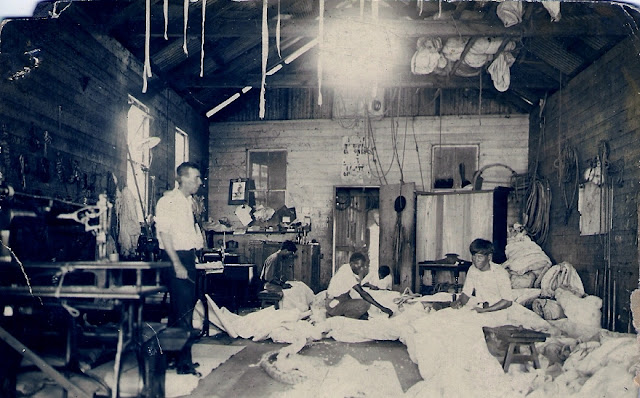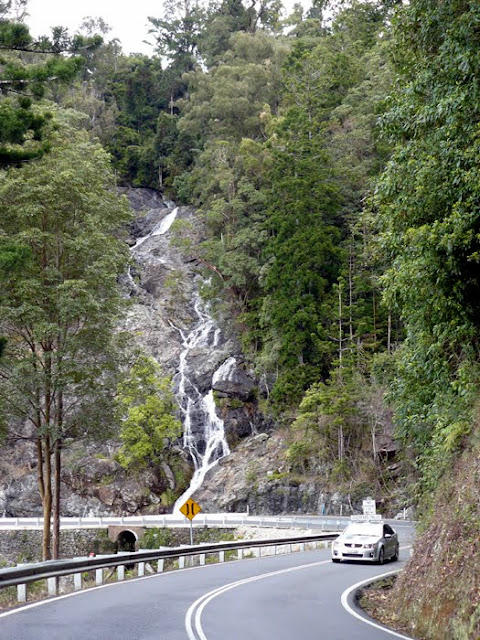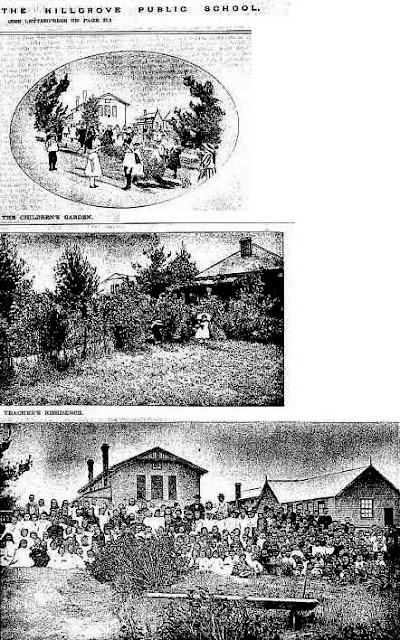Levuka today.
Fiji, the McGowans of Levuka; my Grandmother Maggie and her American beau, ChasBert - the grandfather of the dual identity; the huge family of Ancestors from years past, and astonishingly the growing number of new cousins resulting from those stories.
Especially this latest one, connected to a particularly puzzling member of the McGowan clan...Alfred James.
There you have it in a nutshell, the subject for this latest instalment in the life and times of the McGowans of Fiji.
AN ACCUMULATION OF COUSINS
Apart from the discovery of heritage the most rewarding aspect of genealogy is the accumulation of new cousins. The recent emergence of a particularly surprising new relation, Jennice Gallagher, is the catalyst for this current chapter in the life and times of my Ancestors.
Jenny Gallagher and I grew up in the same town, we lived only miles apart. We probably passed by each other as children and later as young women shopping in Brisbane’s central city, attending movies, dances at Cloudland, hopping on and off trams and buses. Only five years separated us in age and we shared the same direct family background. Our grandparents were brother and sister and we should have grown up at least on a first name basis.
But both of us, back in those childhood days, were completely ignorant of our intertwined past, unaware of the other‘s existence. Until now. So many years later.
 |
| Two little girls growing up in Brisbane |
I will get back to Jennice, but first a glance at the long road my stories have travelled.
_______
FLIRTING WITH THE PAST
 |
| Maggie and Charles, with youngest daughter Rewa in Bundaberg and Sydney |
In the past few years I’ve published over 130 stories. That’s quite a haul and its hard to explain just how they evolved. Perhaps in one chapter writing about my Grandmother Maggie’s death when I hazard the suggestion that she has taken over my computer’s keyboard, controlled my tapping fingers, just might explain the eerie feeling I have when a story emerges.
There have been moments when I’ve pieced together some newly found clues and wondered how they suddenly appeared, by divine intervention? Is such a thing possible and in any case how on earth could you combine the two, modern technology and the supernatural.
But hold on a moment, this is after all the 21st Century. Communication has entered the realms of black magic. The colossus of internet technology has cut through time and space providing enormous fodder for info hunters and gatherers like me; a simple Google request making an absolute mockery of time wasting research.
Who could have imagined not all that long ago for instance that an item published on the web could whip around the world at such enormous speed and be read and digested in an instant by people in countries so diverse as Argentina and Canada, Russia, India, Ecuador, China, England, Germany and Italy, Japan, France, Fiji and New Zealand, and even Afghanistan and Oman.
Of course I’m both tickled pink and humbled that people are reading these stories. It’s always nice to know you have an audience.
But the real reward, for me at least, are those particular readers who connect with a name or a place, recognize a distant kinship and make instant contact. They are my accumulation of cousins, and I treasure each and every one of them.
They bring my past to life, put faces to the aunts and uncles, cousins and distant kin that came long before me, and before them.
The Flemings in England, Kim and Peter, father and son were among the first to surface. We share the common bond of belonging to the widespread and prolific Sweeny family from Sussex. And when I say prolific, I mean exactly that, after all a family of 16 little Sweeny’s does provides exceptional grist for a writers mill. This one anyway.
You’ve read the stories that started with the Four Sisters from Sussex* gathering momentum as the young women travel to the gold fields of Ballarat in Australia, detour to Fiji in the story Suddenly in Fiji* about great Gran Geraldine, provide new plots and timelines in France and on remote Pacific Islands with From Orphan to WW1 Pilot*, before culminating in the numerous chapters about my conniving American Grandfather in Australia and his Quaker forebears in the States.
All the while these globe trotting stories were introducing me to hitherto unknown cousins right here in Australia and New Zealand, Malcolm Kirkwood, Kim Sweeny, Vivienne Stone, Sandra Gally, the Marlow’s, Bob Hooke, Felicia Tungi, Talei Robinson, Wendy Young; Anna Haggerty and Elizabeth Sorensen; Alyson Argument in the UK; Linda and Cindy Babiuk in Canada; and again in Australia an immediate, though long lost first cousin Peter Brown who recognized our paternal Grandfather’s front line service in the Boer War, related in the story Two Wars Two Charlie Brown’s*.
These marvellous contacts were followed by an avalanche of distant American relations following the emerging Quaker series, Terri Porcelli, Rebecca Meloni, Marion Baker, Chris Pigott, Harley Page, David Nelson and Phil McGinty.
And now contact has been made with Jenny Gallagher, this latest and most immediate cousin who has surfaced virtually in my own backyard.
__________
FIJI – THE CATALYST
In our childhood Jenny and I were both nurtured with stories of Fiji. Our Grandparents were brother and sister, Maggie and Alfred McGowan; together with William, Gordon and Andrew the siblings grew up together with their parents William and Geraldine on the lush tropical islands of Fiji... Kadavu, Ovalau and Viti Levu.
At varying times in our own lives Jennice and I each made odysseys to those tiny specks in the Pacific Ocean, endeavouring to make closer contact with a time and a place that held such importance in our ancestors lives.
At that stage we were completely unaware of the others existence.
From an early age we had each been told stories of Fiji, had listened to the haunting melody of the Isa Lei played on old gramophone turntables, accepted as normal the catchphrases of Fijian words that interspersed our grandparents daily life.
There are many parallels in our lives, Jenny’s and mine. We each grew up in the close company of much loved Grandparents. Readers of my stories know the special bond I shared with Maggie Brown Parker, my Fiji born grandmother who died in Brisbane in 1973 at the age of 96.
Jenny’s grandfather Alfred James McGowan, was Maggie Brown Parker’s older brother. He too died in Brisbane, in 1965 aged 92.
How could it be that a brother and sister should end their long lives in such close proximity, only short miles apart, each with their immediate family close by and yet have no idea whatsoever of the other’s whereabouts.
Tears spring when I think of the lost moments they could have shared, the reminiscing of childhood memories, the loss of questions asked and answered.
_________
THE PUZZLE OF ALFRED JAMES
For me Alfred James has always been the puzzle in my great Grandmother Geraldine’s McGowan family. Was he her first born, her second, or her third child? Was he born in Ballarat in 1870, the illegitimate son of Geraldine Sweeny who surfaced soon after in Fiji and married the sea going captain William McGowan.
Or was that first born child lost forever on the goldfields of Ballarat, his young mother taking flight to Fiji where her destiny was decided when she met and married her Scots mariner.
This brother, Alfred James, has always been the stumbling block in the telling of my Gran’s story. I had almost given up hope of ever solving the puzzle until Jenny Gallagher made contact.
In the interim of course, Jenny too had spent years wondering about her own family and their connection to Fiji.
These next photos were taken in adjoining Brisbane suburbs 9 years apart.
 |
| Maggie's 92nd Birthday 1969 Brisbane |
 | ||
| 87 year old Alfred James with his wife Ellen 1960, Brisbane |
In the photograph celebrating Maggie’s 92nd birthday she is surrounded by family, her three daughters Rewa, Leota and Viti, Standing behind her is my husband Stan, Maggie’s Foreman niece Edith Whiteman, Viti’s Austrian husband Irwin, daughter in law May Brown Parker and my brother Charles Brown. Beside Maggie is me with my children, Steve and Jenny.
By the time that photo was taken Gran’s brother Alf had been dead four years, but prior to that the two, brother and sister had been in reasonably good health, their memory unimpaired. Alf was alive for Maggie’s previous birthdays. They should have been reunited.
The sad irony of these two photos is that they were taken in homes no more than two or three miles apart.
___________
ALFRED JAMES IN AUSTRALIA
For Jenny Gallagher, finding me and the McGowan Fiji stories I’ve posted on the internet provided more questions than answers. For me, finding Jenny filled in a colossal number of blank spots, but still didn’t solve the problem of Alfred James McGowan’s birth place and date.
He remains a mystery. In more ways than one.
Especially for Jennice.
Jenny has always accepted as fact that her Grandfather married her grandmother Ellen Bemi in Fiji in 1910. Three years later Jenny’s father Allan James was born. He was followed by Kenneth, Buster and Gordon. Roland had died age 2 and was buried in Levuka.
 |
Alfred and Ellen’s sons, Allan, Kenneth, Buster and Gordon McGowan
|
Jenny had wonderful memories of growing up with her parents, Allan and Ruby McGowan. Of days spent sailing on Moreton Bay, of visits as a child to Stradbroke Island where, coincidentally, I have lived for the past 34 years.
She knew her grandparents well, as I too had known mine. Always in the back of her mind was the intention to write her life story, a story that flirted and danced, like mine, around our Fiji born grandparents.
In a way I have beaten her to it. I’ve taken the Fiji story back to Maggie and Alfred’s parents, to our great grandmother Geraldine Sweeny, and Scots grandfather William McGowan. In delving into the past I’ve uncovered a family saga that covers several generations and even more countries.
I sought and followed a paper trail, tracing back the McGowan children, their birth, marriages and what became of them but concentrating mainly on Maggie and her American husband, Charles Brown Parker whose real name I found, was Bert Brown.
In the ensuing years I made contact with numerous offspring of the original McGowan youngsters, but when it came to Alf’s life I was faced virtually with a blank wall. An absence of documentation from a time in Fiji’s colonial history when Government was in flux and records were poorly kept.
For Jenny Gallagher her father Allan and Grandfather Alfred’s lives were self evident. She knew her grandparents intimately, they were her constant companions. For her their history was crystal clear. She had no reason to doubt it.
Her grandfather Alfred married her grandmother Ellen Bemi in Fiji in 1910 and together they produced five sons, eventually moved to Australia, established their home in Brisbane and saw their sons grow into fine young men. Her story was not unlike that of my grandparents and their offspring and their move first to New Zealand and then to Australia.
With all this news about Alfred I should be thrilled, and I am; to find Jenny and her extended family is a bit like all my Christmas’s and birthday’s rolled into one. The trouble is, I had a spanner to throw into the works, a parallel history for Alfred, and one Jenny Gallagher knew nothing about.
In my years of researching the McGowans I made and subsequently lost contact with another young woman, Felicia Tungi, who wrote to tell me her grandfather was Alfred James McGowan, her father was his son Alfred Felix, and her father had a brother who was Allan James McGowan. But as this young woman told me, her grandfather Alfred had been married to Mafile’O Fohe, the daughter of a nobleman of Tonga.
And Jenny Gallagher had never heard of Alfred Felix, nor of the young woman from Tonga.
The mystery surrounding Alfred James was deepening by the minute.
 |
Alfred James McGowan in the Levuka sail loft. Photo from Jenny Gallagher’s album.
|
 |
Geraldine with her McGowan children, William and Gordon, Maggie, Andrew and Alfred, the tall man in the group photo may be Geraldine's son in law.
|
But is Alfred’s life really such a mystery. Rather than hiding his past could Alfred have merely compartmentalised his life in much the same way young people of today do. In Victorian times marriage was expected to last a life time. In the modern communities of today this is no longer the case.
In much the same way my grandparents, Maggie and Chas, thought it necessary to keep hidden their true identity, perhaps Alfred may have decided to keep separate his two families.
Neither Maggie nor Alfred could possibly have imagined their grandchildren would be interested in family events that took place a century and more before. Probably never gave a thought to paper trails and inquisitive grand daughters.
Could never have realised the close bond to family and Fiji that they themselves had so lovingly instilled in their small grand-children’s hearts and minds.
And neither should really be surprised nor threatened by the stories and secrets we’ve uncovered...
Alfred James McGowan’s life story is Jenny Gallagher’s to tell, and I look forward to reading it.
If it’s anything like that of his sister and his mother, Maggie and Geraldine, it’s sure to be a block buster.
_________
Robyn Mortimer ©2012





















